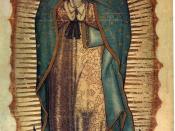"There is no doubt that everyone is called to repent and convert, but, practically speaking, conversion means totally different things to different people, depending on where they are within socio-cultural structures" (Elizando 2002: 81). In his book, Guadalupe: Mother of the New Creation, Virgil Elizando explores and illustrates the truth in the above statement, and how this change of heart, called conversion, is actually brought about. He does this by comparing the means and methods of conversion by the Spanish - with their violent, forced re-culturation, and attempted "European-ization" of the Nahuatl, with that of the apparition of La Virgen de Guadalupe. La Madrecita Querida, (the Blessed Mother,) a messenger of the true gospel and mother of the living Christ brought hope, love, acceptance, empowerment, and an embracing of the Nahuatl people, history, and culture - which resulted in the opportunity for their true conversion to Christianity.
The Spanish conquistadors that arrived in the New World were confronted with a plethora of indigenous people groups - these groups stood out as bizarrely different from the Europeans, in their language, clothing, culture, and most importantly, their religious practices, which included some human sacrifice, blood-letting, and a veritable pantheon of gods and goddesses.
The Spaniards came to the rescue - with their God, religion, & most importantly their armies, to save the native peoples from themselves. These simple people appeared to the cultured Europeans as lesser beings, created just a little higher than the beasts, incapable of being trusted, but with a desperate need for conversion from their obviously pagan and demonic ways. However, the conversion that the Nahuatl were presented with by the Spanish priests had very little to do with the change of heart described by Elizando. Conversion meant that all aspects of Nahuatl culture would be removed and rejected.


